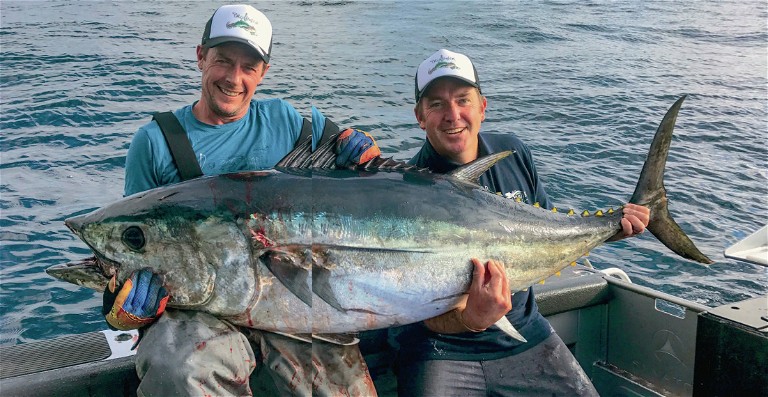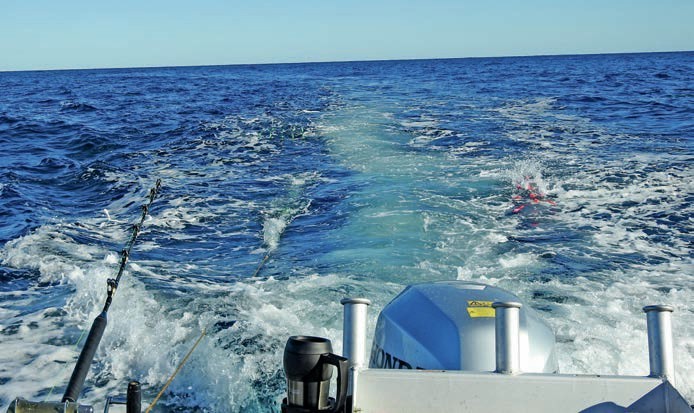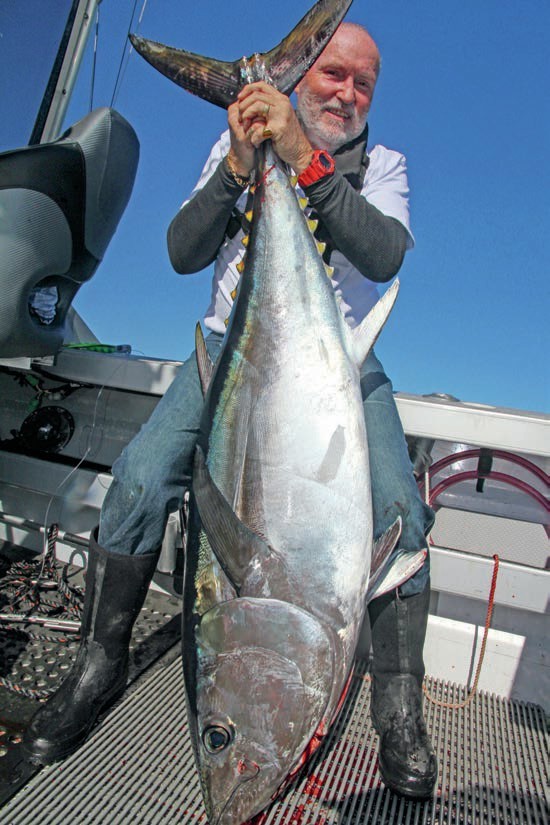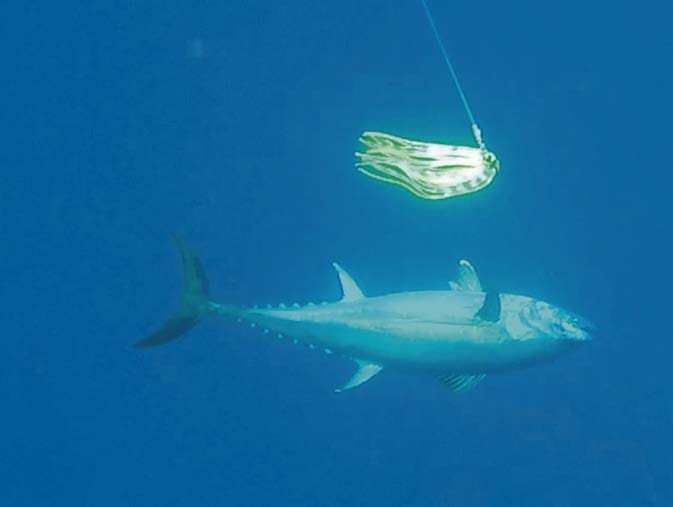LET’S GO GET A TUNA
Story and Photos: Pete McGregor, Bonze Lures Graphic: Glenn Kipling
It’s time to get ready for the southern bluefin tuna run. If they turn up off the East Cape again around July this year, then you will need to be ready at the drop of a hat to head off to Whakatane or Waihau Bay to tackle them. So, let’s look at how to prepare both your boat and your tuna setup so that you can take full advantage of the opportunity. I have enlisted the help of Graeme Fleet from Bonze Lures to assist me in preparing this information.
Boat Preparation
Cape Runaway is where deep water comes closest to New Zealand’s shores. There is a trench there, around 11 nautical miles off the Cape, where the water depth drops to 1000 metres. From there it continues deeper – afurther 10nm out to sea it reaches 2000m. This is tough territory, with tremendous currents and potentially strong winds, so fishing there is not for the faint-hearted. If you plan on fishing there, make sure you have adequate food and water on board, as well as warm clothing (heaps of warm clothing!) – it can get very cold.
The change of light is a good bite time, so be prepared to get on the water early. It will be pitch dark and, with so many boats on the water, quite stressful. If you use a spotlight on your boat, then do so sparingly and please be aware that you will not be popular as it effectively wipes out the night vision for everyone else. A better option is to station guys on the boat to act as your guides or splash out on a Flir scope.
Invest in a wash-down pump or a good bucket. Tuna emit a huge amount of blood. Buy heaps of salt ice and put it in the boat the night before going out. The pub at Waihau Bay sells salt ice and serves very good meals.

Preparation of your boat is essential. It goes without saying that you need to have a very reliable motor, lifejackets, and VHF radio. An EPIRB is also a good option.
Fuel is also an issue. There is a 24hr pay-bycard bowser at Waihau Bay, but it is very close to the launching ramp and getting to it can be a problem as you have to wait in the launching queue for access. You will need lots of fuel on the boat. If you find the fish are at 1800m depth, it’s a long way to that point. Another option is driving 30 mins along the windy road back along the coast to the next closest service station. The Waihau Bay fuel bowser actually ran out a couple of years ago when there were 188 boats trying to get fuel!
Launching fees at Waihau are $5, payable either online or at the ramp. Alternatively, you can join the Club for $80 per year. They provide a tremendous service and a top-class launching ramp. Although the bag limit that came into force on June 2019 allows a recreational limit of one SBT per day per person, the Waihau Bay Sports Fishing Club and community would prefer to see one fish per boat, per day, taken.
Dredges and Teasers
Tuna love top-water splashy things. Graeme Fleet says a dredge is not essential, but he likes to run one, nevertheless.
Graeme suggests that everything you run should have a lure on it (except the dredge obviously). Firstly, tuna are very shy of leaders and running a lure/teaser combination reduces the visibility of leaders. Secondly, nothing is wasted. Tuna will attack in a pack and will attack everything they see, so the more lures in the water the better. There is nothing worse than losing a lure head from a teaser because it had no hooks in it. He does not advocate using a ‘Volcano’ teaser for tuna, again because it has no lure attached.
Lures
Now the fun part begins! Here are some of Graeme’s suggested approaches (all of these are designed so you can fight the fish with the teaser in place).
Bird teaser
This is a pretty robust gadget that creates a lot of splashes. Combine it with a bigger angle-face lure (creating even more splash) and run it in the short shotgun position. While the Bonze one has been designed with inbuilt strength to cope with fighting a fish, most of the other ones on the market will need a backup bypass leader in case of failure. Run the lure round 1-metre maximum behind the bird.
Thannus Squid Chain
This is a great option to run a lure from. Multiple in-line brightly coloured squids create a lot of surface commotion. A lure is added close to the last squid. So, again, only use a very short leader to the lure – about the same length as the gap between the squid elements. Use a bullet or cut face lure, and run the rig in the short corner position.
Thannus Pro Spread Bar
Run this fellow either on the long corner outside the Volcano (if you are using one), or swap positions with the Bird teaser rig so this one runs in a short shotgun position, right in the middle, relatively close behind the boat. It’s a bit of an awkward beast to handle with so many elements to get tangled up on the boat, but once it’s running it creates the most amazing effect and surface commotion, and it hides the leader. Tip:
Remove all the packaging twisty ties from the new Thannus rig before you get anywhere near the boat. It is otherwise a good twenty-minuteplus exercise to get it ready to deploy.
For the balance of your spread, run small splashy lures like the Bonze Merlin or D Shackle on the short and long riggers. Don’t be afraid to run a full spread of five or even six lures, if you can do so. Run your short and long corner lures via the close-in position on your outriggers, i.e., all four rods running via outriggers (see diagram). This gets the lures out away from your wake and creates a gap behind the boat to run a close-in teaser/ lure shotgun, and maybe a second shotgun lure way out back.
Graham suggests that as another option you could look at is running a lure with a paravane to create a diving lure on the short corner.
Fit your lures with a pair of size 8 or 9 stainless closed-gap steel hooks for holding power. This is shorter than what’s normal for marlin, but it gives more chances for hook-ups.
Use a 300lb leader for lure/ teaser combinations, with 200lb being normal for unaccompanied lures.
Run your drag at 8kg and troll at between 6.5 and 7.5 knots.
You cannot troll these lure/teaser combinations too fast or they will continually pop out of the rigger clips and even pull line off the reel.

Pete’s tuna spread.
Most strikes will come from fish swimming with the current. They are chasing baitfish that cannot swim against the current.
The best bite will be at the change of light, early or late in the day.

Jack Lucas showing the strain of holding a fat tuna.

1) Teasers in action.
Tuna aren’t like marlin. When they take a lure they will go down.
If only one lure is taken, keep trolling for a wee while. Tuna attack in packs, so chances are you will hook more if you keep going.
Though, I would suggest that if you get three on it would be a good time to slow down!
You do not need to turn the boat after you have a fish on. Just keep moving at a reduced speed until you get the gear in. Then, stop the boat and fight the fish. It’s easy enough to fight multiple fish at one time because they will be below you. However, obviously you will still need to watch for crossed lines.
Once you have your fish at the surface, you can leader and gaff whichever one you want to keep, using a good fixed-head gaff. Note that the club will only weigh one fish per boat, so releasing excess fish is a must.
You should immediately bleed your fish. Unless you are weighing the fish, consider cutting it up right there and then and getting it into the chilly bin on ice. Dispose of carcasses at sea. If keeping the fish, you need to get it on ice as soon as possible to get the body temperature down. I cannot stress how important this is.
I hope this gives you some ideas and sparks your enthusiasm to get into these great fighting fish.
Please remember to be respectful of the local community while you are in their wonderful part of New Zealand.

2) Pete with a nice southern bluefin tuna.

3) Pete, hooked up and happy.

4) A hooked tuna circles under the boat.